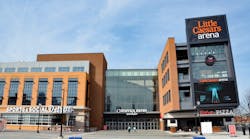In the commercial interior design space, sports and entertainment venues is an emerging market.
These venues have been around almost as long as civilization, but recent economic opportunities and advancing technologies have sparked revitalization in this market that are giving fans and players an entirely new experience.
There’s been an overall shift in how stadiums are designed. Owners and designers have learned that fans want more than a building, they want a relationship. They want to feel connected to the facility that lives in their city and plays host to their lifelong memories.
[On topic: 2020 Trends and Predictions for Convention, Sports and Entertainment Venues]
3 Ways to Create a Memorable Stadium Experience
Here are three ways to incorporate local touches and unique experiences to create a memorable stadium.
1. Infusing Local Touches
To build this bond, stadium designers are increasingly sensitive to the local community and what makes it unique. More often they use what happens outside a stadium—local history and current culture—to inspire what happens inside it—food, décor, amenities, etc.
[Related: How to Manage Food Trucks Outside Your Building]
Little Caesars’ Arena is an excellent example of this. Designers used Detroit’s rich musical history and resilient manufacturing background as inspiration for the building’s interior.
Inside features restaurants honoring hometown music heroes, dim lighting reminiscent of the jazz era, industrial bones that were left uncovered and—at one entrance—an intimidating-looking muscle car is mounted vertically as if it drove straight off the concourse and swerved daringly into a brick wall.
2. Variety of Seating Options
Another significant change is in viewing options. Venues are beginning to offer a variety of seating and dining options, at a variety of price points, so fans can choose experiences that feel one-of-a-kind and unique to their preferences.
Traditional stadium seating is being replaced with casual, communal cluster spaces, where fans can see and interact with their favorite team members. In Little Caesars Comerica Players Club, fans come face-to-face with players as they go to and from the ice.
In the Bunker Club at Mizzou’s Memorial Stadium, fans can high five athletes as they hit the ground.
[Looking for products? 27 Award-Winning Interior Products for Your Commercial Building]
3. Consider Recruitment Amenities
Another shift is triggered by recruitment. Coaches and staff must have state-of-the-art facilities in order to be competitive. For Mizzou, this means building advanced weight rooms, spaces for hydro and cryotherapy, nutrition centers and tailor-made locker rooms.
In the increasingly difficult war for talent, leadership must demonstrate their commitment to athlete success, both on and off the field.
When people leave an arena, they might not remember the seats or even if their team won or lost. When people leave an area, they leave with a memory of how they felt, what they did and the people they were with.
Sports have always been about bringing people together and it’s good to see the tradition continue in stadiums of the future.
About the Authors:
Gary Arthur is senior project manager with Color Art Sports, a project management company based in St. Louis.
Ashley Flynn is a staff writer with Color Art Sprots. Color Art Sports has been worked on some of the largest stadium projects in the country: Little Caesars Arena, National’s Ballpark, Amway Center and Busch Stadium, among others.
Two handpicked articles to read next:


